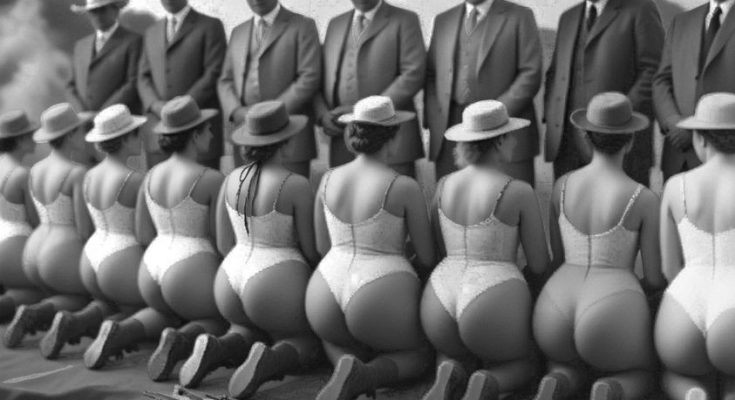Imagine a time when societal expectations for women weren’t just stringent; they were downright oppressive. In an era when gender roles were clearly defined, there existed a bizarre and often forgotten tradition—one that forced women, particularly wives, to publicly kneel before their husbands in an act of humble apology. This strange custom, primarily practiced in the late 1800s and early 1900s, is a jaw-dropping reminder of how far we’ve come in terms of gender equality. But how exactly did such a ritual evolve, and what does it tell us about the expectations placed upon women during that time?
Buckle up for a journey back in time, where the personal relationships of husbands and wives were bound not only by love or duty but also by deeply entrenched cultural norms that placed women in an undeniably submissive position.
The Custom: A Yearly Act of Submission
At the turn of the century, one of the most shocking customs was the annual practice that took place on December 31st—the final day of the year. It wasn’t just a time to reflect on the past and make New Year’s resolutions. For wives, this day signified a much darker obligation. As the old year drew to a close, women were expected to physically kneel before their husbands, an act of deep humility, and offer an apology for any perceived wrongdoings they may have committed throughout the year.
This was no private act of reconciliation within the household walls. In many communities, it was a public ceremony, often performed in the presence of other family members, neighbors, or even the local church congregation. Wives would bow their heads, sometimes clasping their hands, in a pose that was disturbingly reminiscent of a servant seeking forgiveness from their master. And for what offenses? Often trivial or imagined—perhaps a raised voice during an argument, a household chore not completed to perfection, or even the perception of neglecting their husband’s emotional or physical needs. Whatever the “mistake,” it was the wife’s role to admit her faults, whether she agreed with them or not.
In a world dominated by patriarchal values, this practice was not merely symbolic—it reinforced the hierarchy within the marriage. The husband was the ruler of the household, the decision-maker, the ultimate authority, and the wife was there to serve. Kneeling in submission solidified this power imbalance in the most literal way possible.
But Why Kneeling? The Roots of the Tradition
You might wonder—why kneeling? How did such a demeaning practice find its place in the fabric of marriage traditions?
Kneeling has historically been a gesture associated with submission, humility, and obedience. In religious contexts, it was—and still is—used as a physical representation of reverence to a higher power. For centuries, it was common for people to kneel before kings, queens, or nobility to show respect or seek pardon. In fact, the concept of “kneeling” to ask for forgiveness is deeply embedded in religious and royal customs.
At the time, many believed that husbands, as the heads of their households, deserved a similar level of respect and veneration. Just as subjects would kneel before their rulers, wives were expected to kneel before their husbands to reinforce the notion that the husband’s authority was absolute. The act of kneeling was also meant to “restore balance” in the relationship—a peculiar balance where men held most of the power and women were expected to remain subservient.
Furthermore, the religious influence on daily life during this era cannot be underestimated. Christian teachings often emphasized the husband as the spiritual leader of the home, a figure to whom a wife must submit in all things. Ephesians 5:22-24, which urges wives to “submit to their own husbands as to the Lord,” was often cited to justify such practices. While not all Christian denominations or cultures practiced this exact custom, the overarching message of female subservience was widely promoted.
The Social Implications: Women as Second-Class Citizens
Though this annual apology ritual might seem bizarre today, it fits within the broader context of how women were viewed and treated in society during the late 1800s and early 1900s. During this period, women were often considered property rather than partners. Legal and social structures placed them squarely under their husbands’ control, with very few rights of their own.
For instance, it wasn’t until the Married Women’s Property Acts (first passed in the mid-to-late 1800s in various regions) that women could even own property in their own name. Before this, any property a woman inherited or earned automatically became her husband’s. The same went for wages—if a woman worked (which was rare for married women at the time), her earnings were legally considered her husband’s. Divorce, too, was a near-impossibility, especially for women. If a woman wanted to leave an unhappy or abusive marriage, she often faced social ruin, financial hardship, and, in many cases, the loss of her children.
Against this backdrop, it’s not hard to see how the idea of a wife kneeling before her husband as an act of submission could flourish. It wasn’t just a random act of control—it was the logical outcome of a society that systematically reduced women’s rights and freedom.
A Change in Attitudes: The Slow March Toward Equality
So, what changed? How did we go from a world where women were expected to kneel before their husbands to one where such an idea would be considered outrageous?
The early 1900s were a period of immense social and political change, especially for women. The suffrage movement, which gained momentum at the turn of the century, began to challenge traditional notions of gender roles. Women started to fight for the right to vote, the right to own property, and the right to control their own destinies. The horrors of World War I and World War II also played a significant role in reshaping societal attitudes toward women, as they were required to take on roles traditionally reserved for men while the latter were off at war.
By the mid-20th century, the idea of women being subservient to their husbands was beginning to lose its hold, though true equality was still a long way off. The feminist movements of the 1960s and 1970s further dismantled the oppressive social structures that had kept women in submissive roles for so long.
Legal reforms gradually granted women more rights within marriage, including the right to divorce, the right to retain custody of their children, and the right to be seen as equals within the household. The old traditions of public humiliation and kneeling in submission were increasingly viewed as barbaric relics of a bygone era, no longer acceptable in a society moving toward gender equality.
A Strange Tradition—But a Powerful Reminder
Today, the idea of wives kneeling in apology before their husbands seems more like the plot of a disturbing historical drama than a real-life tradition. It’s hard to imagine a world where such acts of public humiliation were not only expected but celebrated as a way to maintain marital harmony.
Yet, this shocking custom serves as a powerful reminder of the oppressive norms women have had to fight against for centuries. The fact that such a practice once existed—and was widely accepted—underscores the importance of continuing to advocate for gender equality and recognizing the long history of women’s struggle for autonomy and respect.
We may no longer kneel in submission, but the echoes of such traditions linger in the way society still, at times, attempts to police women’s bodies, choices, and behaviors. By remembering and understanding these bizarre and troubling customs, we can ensure that history doesn’t repeat itself and that every individual—regardless of gender—can stand tall in a world of true equality.



